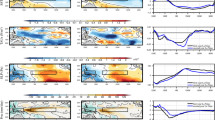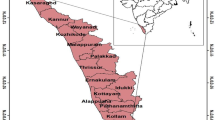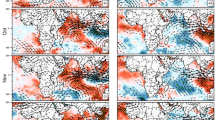Abstract
Under global warming, heatwaves over India are projected to increase unequivocally. Thus, understanding the causal mechanisms responsible for heatwaves adds immense value to the country’s climate change mitigation and adaptation strategies. Although several studies have attempted to understand the physical mechanisms responsible for such events, efforts focusing on South-West India (SWI) are lacking. Here, using long-term observational data (1951–2020) and climate model simulations, we show that the heatwaves over SWI are influenced by major climatic modes, including El Niño–Southern Oscillation (ENSO), Pacific Decadal Oscillation (PDO), and the Indian Ocean Dipole (IOD). The mechanism through which these climatic modes affect the SWI heatwaves is either by weakening of Pacific Walker circulation (ENSO and PDO) or by strengthening the Indian Ocean Hadley circulation (IOD). Further, we found that amongst these climatic modes, PDO explains the majority of the heatwave variability followed by IOD. However, post-1979, the scenario has changed remarkably with ENSO gaining prominence, signifying the strengthening of the relationship between ENSO and SWI heatwaves in the recent past. Overall, our study provides a first insight into the drivers and mechanism of the SWI heatwaves, whose value to designing heatwave adaptation strategies over the ecologically sensitive region can hardly be overemphasised.








Similar content being viewed by others
Data availability
The daily maximum temperature data from the IMD can be procured from https://www.imdpune.gov.in/cmpg/Griddata/Max_1_Bin.html. The large-scale atmospheric variables used in the present study can be downloaded from: NCEP-NCAR reanalysis data (https://psl.noaa.gov/data/gridded/data.ncep.reanalysis.html). The climate indicators used in the present study can be procured from: ENSO (https://origin.cpc.ncep.noaa.gov/products/analysis_monitoring/ensostuff/ONI_v5.php), PDO and IOD (https://psl.noaa.gov/gcos wgsp/Timeseries/). The GPP data can be procured from https://daac.ornl.gov/cgi-bin/dsviewer.pl?ds_id=1789.
References
Andreoli RV, Kayano MT (2005) Enso-related rainfall anomalies in South America and associated circulation features during warm and cold pacific decadal oscillation regimes. Int J Climatol J R Meteorol Soc 25(15):2017–2030
Barriopedro D, Fischer EM, Luterbacher J, Trigo RM, García-Herrera R (2011) The hot summer of 2010: redrawing the temperature record map of Europe. Science 332(6026):220–224
Bayr T, Dommenget D, Martin T, Power SB (2014) The eastward shift of the walker circulation in response to global warming and its relationship to enso variability. Clim Dyn 43:2747–2763
Bellprat O, Guemas V, Doblas-Reyes F, Donat MG (2019) Towards reliable extreme weather and climate event attribution. Nat Commun 10(1):1–7
Benjamini Y, Hochberg Y (1995) Controlling the false discovery rate: a practical and powerful approach to multiple testing. J R Stat Soc Ser B (Methodol) 57(1):289–300
Bi J, Chung J (2011) Identification of drivers of overall liking-determination of relative importances of regressor variables. J Sens Stud 26(4):245–254
Chaudhury S, Gore J, Ray KS (2000) Impact of heat waves over India. Curr Sci 79(2):153–155
Dai A (2011) Drought under global warming: a review. Wiley Interdiscip Rev Clim Change 2(1):45–65
Dai A (2013) Increasing drought under global warming in observations and models. Nat Clim Chang 3(1):52–58
Data C (2009) Guidelines on analysis of extremes in a changing climate in support of informed decisions for adaptation. World Meteorological Organization
Di Capua G, Kretschmer M, Donner RV, Van Den Hurk B, Vellore R, Krishnan R, Coumou D (2020) Tropical and mid-latitude teleconnections interacting with the Indian summer monsoon rainfall: a theory-guided causal effect network approach. Earth Syst Dyn 11(1):17–34
Duffy KA, Schwalm CR, Arcus VL, Koch GW, Liang LL, Schipper LA (2021) How close are we to the temperature tipping point of the terrestrial biosphere? Sci Adv 7(3):1052
Gershunov A (1998) Enso influence on intraseasonal extreme rainfall and temperature frequencies in the contiguous United States: Implications for long-range predictability. J Clim 11(12):3192–3203
Gershunov A, Barnett TP (1998) Interdecadal modulation of ENSO teleconnections. Bull Am Meteor Soc 79(12):2715–2726
Gill EC, Rajagopalan B, Molnar P (2015) Subseasonal variations in spatial signatures of ENSO on the Indian summer monsoon from 1901 to 2009. J Geophys Res Atmos 120(16):8165–8185
Govardhan G, Nanjundiah RS, Satheesh S, Krishnamoorthy K, Kotamarthi V (2015) Performance of WRF-CHEM over Indian region: comparison with measurements. J Earth Syst Sci 124:875–896
Grömping U (2007) Relative importance for linear regression in r: the package relaimpo. J Stat Softw 17:1–27
Grömping U (2007) Estimators of relative importance in linear regression based on variance decomposition. Am Stat 61(2):139–147
Hari V, Pathak A, Koppa A (2021) Dual response of Arabian sea cyclones and strength of Indian monsoon to southern Atlantic ocean. Clim Dyn 56(7):2149–2161
Hari V, Ghosh S, Zhang W, Kumar R (2022) Strong influence of north pacific ocean variability on Indian summer heatwaves. Nat Commun 13(1):5349
Hari V, Rakovec O, Zhang W, Koppa A, Collins M, Kumar R (2024) On the role of the Atlantic meridional mode in eastern European temperature variability. Atmos Res 297:107082
Im E-S, Pal JS, Eltahir EA (2017) Deadly heat waves projected in the densely populated agricultural regions of South Asia. Sci Adv 3(8):1603322
Johnson JW, LeBreton JM (2004) History and use of relative importance indices in organizational research. Organ Res Methods 7(3):238–257
Kalnay E, Kanamitsu M, Kistler R, Collins W, Deaven D, Gandin L, Iredell M, Saha S, White G, Woollen J (2018) The ncep/ncar 40-year reanalysis project. In: Renewable energy. Routledge, pp 1–1461194
Kishore P, Basha G, Venkat Ratnam M, AghaKouchak A, Sun Q, Velicogna I, Ouarda T (2022) Anthropogenic influence on the changing risk of heat waves over India. Sci Rep 12(1):3337
Krishnamurthy L, Krishnamurthy V (2014) Influence of PDO on South Asian summer monsoon and monsoon-ENSO relation. Clim Dyn 42:2397–2410
Kucharski F, Molteni F, King MP, Farneti R, Kang I-S, Feudale L (2013) On the need of intermediate complexity general circulation models: a “speedy’’ example. Bull Am Meteor Soc 94(1):25–30
Kumar N, Jaswal A, Mohapatra M, Kore P (2017) Spatial and temporal variation in daily temperature indices in summer and winter seasons over India (1969–2012). Theoret Appl Climatol 129:1227–1239
Lau K, Yang S (2003) Walker circulation. Encycl Atmos Sci. https://doi.org/10.1006/rwas.2002.0450
Li T, Wang B, Chang C, Zhang Y (2003) A theory for the Indian ocean dipole-zonal mode. J Atmos Sci 60(17):2119–2135
Lindeman RH, Merenda PF, Gold RZ (1980) Introduction to bivariate and multivariate analysis. (No Title)
Madani N, Parazoo NC (2020) Global monthly GPP from an improved light use efficiency model, 1982–2016. ORNL Distrib Act Arch Center. https://doi.org/10.3334/ORNLDAAC/1789 (https://daac.ornl.gov/cgi-bin/dsviewer.pl?ds_id=1789)
Mantua NJ, Hare SR (2002) The pacific decadal oscillation. J Oceanogr 58:35–44
Mantua NJ, Hare SR, Zhang Y, Wallace JM, Francis RC (1997) A pacific interdecadal climate oscillation with impacts on salmon production. Bull Am Meteor Soc 78(6):1069–1080
McPhaden MJ, Zebiak SE, Glantz MH (2006) Enso as an integrating concept in earth science. Science 314(5806):1740–1745
Meehl GA, Tebaldi C (2004) More intense, more frequent, and longer lasting heat waves in the 21st century. Science 305(5686):994–997
Mishra V, Mukherjee S, Kumar R, Stone DA (2017) Heat wave exposure in India in current, 1.5 c, and 2.0 c worlds. Environ Res Lett 12(12):124012
Molteni F (2003) Atmospheric simulations using a gcm with simplified physical parametrizations. i: Model climatology and variability in multi-decadal experiments. Clim Dyn 20(2):175–191
Murari KK, Ghosh S, Patwardhan A, Daly E, Salvi K (2015) Intensification of future severe heat waves in India and their effect on heat stress and mortality. Reg Environ Change 15:569–579
Murari KK, Sahana A, Daly E, Ghosh S (2016) The influence of the El N iño Southern Oscillation on heat waves in India. Meteorol Appl 23(4):705–713
Naveena N, Satyanarayana GC, Rao KK, Umakanth N, Srinivas D (2021) Heat wave characteristics over India during ENSO events. J Earth Syst Sci 130:1–16
Nguyen H, Hendon H, Lim E-P, Boschat G, Maloney E, Timbal B (2018) Variability of the extent of the Hadley circulation in the southern hemisphere: a regional perspective. Clim Dyn 50:129–142
Nowack P, Runge J, Eyring V, Haigh JD (2020) Causal networks for climate model evaluation and constrained projections. Nat Commun 11(1):1415
Osman M, Alvarez MS (2018) Subseasonal prediction of the heat wave of December 2013 in southern South America by the poama and bcc-cps models. Clim Dyn 50(1–2):67–81
Pai D, Nair S, Ramanathan A (2013) Long term climatology and trends of heat waves over India during the recent 50 years (1961–2010). Mausam 64(4):585–604
Ping J, Cui E, Du Y, Wei N, Zhou J, Wang J, Niu S, Luo Y, Xia J (2023) Enhanced causal effect of ecosystem photosynthesis on respiration during heatwaves. Sci Adv 9(43):6395
Power SB, Smith IN (2007) Weakening of the walker circulation and apparent dominance of el niño both reach record levels, but has ENSO really changed? Geophys Res Lett 34(18)
Power SB, Kociuba G (2011) What caused the observed twentieth-century weakening of the walker circulation? J Clim 24(24):6501–6514
Power S, Casey T, Folland C, Colman A, Mehta V (1999) Inter-decadal modulation of the impact of ENSO on Australia. Clim Dyn 15:319–324
Rasmijn L, Schrier G, Bintanja R, Barkmeijer J, Sterl A, Hazeleger W (2018) Future equivalent of 2010 Russian heatwave intensified by weakening soil moisture constraints. Nat Clim Chang 8(5):381–385
Ratnam J, Behera SK, Ratna SB, Rajeevan M, Yamagata T (2016) Anatomy of Indian heatwaves. Sci Rep 6(1):24395
Rayner N, Parker DE, Horton E, Folland CK, Alexander LV, Rowell D, Kent EC, Kaplan A (2003) Global analyses of sea surface temperature, sea ice, and night marine air temperature since the late nineteenth century. J Geophys Res Atmos 108(D14)
Rohini P, Rajeevan M, Srivastava A (2016) On the variability and increasing trends of heat waves over India. Sci Rep 6(1):1–9
Rohini P, Rajeevan M, Mukhopadhay P (2019) Future projections of heat waves over India from cmip5 models. Clim Dyn 53:975–988
Roxy MK, Ritika K, Terray P, Murtugudde R, Ashok K, Goswami B (2015) Drying of Indian subcontinent by rapid Indian ocean warming and a weakening land-sea thermal gradient. Nat Commun 6(1):7423
Roy SS (2006) The impacts of ENSO, PDO, and local SSTS on winter precipitation in India. Phys Geogr 27(5):464–474
Runge J, Nowack P, Kretschmer M, Flaxman S, Sejdinovic D (2019) Detecting and quantifying causal associations in large nonlinear time series datasets. Sci Adv 5(11):4996
Sahana A, Ghosh S, Ganguly A, Murtugudde R (2015) Shift in Indian summer monsoon onset during 1976/1977. Environ Res Lett 10(5):054006
Sharma T, Vittal H, Karmakar S, Ghosh S (2020) Increasing agricultural risk to hydro-climatic extremes in India. Environ Res Lett 15(3):034010
Shi L, Kloog I, Zanobetti A, Liu P, Schwartz JD (2015) Impacts of temperature and its variability on mortality in New England. Nat Clim Chang 5(11):988–991
Singh A, Thakur S, Adhikary NC (2020) Influence of climatic indices (AMO, PDO, and ENSO) and temperature on rainfall in the northeast region of India. SN Appl Sci 2:1–15
Spirtes P, Glymour C (1991) An algorithm for fast recovery of sparse causal graphs. Soc Sci Comput Rev 9(1):62–72
Srivastava A, Rajeevan M, Kshirsagar S (2009) Development of a high resolution daily gridded temperature data set (1969–2005) for the Indian region. Atmos Sci Lett 10(4):249–254
Trenberth KE (1990) Recent observed interdecadal climate changes in the northern hemisphere. Bull Am Meteor Soc 71(7):988–993
Vittal H, Karmakar S, Ghosh S, Murtugudde R (2020) A comprehensive India-wide social vulnerability analysis: highlighting its influence on hydro-climatic risk. Environ Res Lett 15(1):014005
Vittal H, Villarini G, Zhang W (2020) On the role of the Atlantic ocean in exacerbating Indian heat waves. Clim Dyn 54:1887–1896
Wang L, Chen W, Huang R (2008) Interdecadal modulation of PDO on the impact of ENSO on the east Asian winter monsoon. Geophys Res Lett 35(20)
Welbergen JA, Klose SM, Markus N, Eby P (2008) Climate change and the effects of temperature extremes on Australian flying-foxes. Proc R Soc B Biol Sci 275(1633):419–425
Wu S, Luo M, Wang X, Ge E, Zhang W, Gu X, Liu J (2023) Season-dependent heatwave mechanisms: a study of southern china. Weather Clim Extrem 42:100603
Xavier AK, Varikoden, H, Babu C, Reshma T (2023) Influence of PDO and ENSO with Indian summer monsoon rainfall and its changing relationship before and after 1976 climate shift. Clim Dyn 1–18
Xu H, Xiao J, Zhang Z (2020) Heatwave effects on gross primary production of northern mid-latitude ecosystems. Environ Res Lett 15(7):074027
Yin J, Gentine P, Slater L, Gu L, Pokhrel Y, Hanasaki N, Guo S, Xiong L, Schlenker W (2023) Future socio-ecosystem productivity threatened by compound drought-heatwave events. Nat Sustain 6(3):259–272
Zhang R-H, Rothstein LM, Busalacchi AJ (1998) Origin of upper-ocean warming and El Niño change on decadal scales in the tropical pacific ocean. Nature 391(6670):879–883
Zhang W, Vecchi GA, Murakami H, Villarini G, Jia L (2016) The pacific meridional mode and the occurrence of tropical cyclones in the western north pacific. J Clim 29(1):381–398
Zore T, Landu K, Gogoi PP, Vinoj V (2021) Effect of tropical sub-seasonal variability on heatwaves over India. Int J Climatol 41:2258–2268
Acknowledgements
VH acknowledges support from the Faculty Research Scheme of IIT (ISM) Dhanbad (FRS(176)/2022–2023/ESE). AK acknowledges support from the European Research Council ERC under grant agreement 101088405 (HEAT). The authors also acknowledge efforts of different organizations/people for making the data available for this work which includes NCEP-NCAR reanaysis and India Meteorology Department (IMD) datasets.
Funding
No specific grant was given to this research by funding organisations in the public, private, or not-for-profit sectors.
Author information
Authors and Affiliations
Corresponding author
Ethics declarations
Conflict of interest
The authors declare that there is no Conflict of interest.
Additional information
Publisher's Note
Springer Nature remains neutral with regard to jurisdictional claims in published maps and institutional affiliations.
Rights and permissions
Springer Nature or its licensor (e.g. a society or other partner) holds exclusive rights to this article under a publishing agreement with the author(s) or other rightsholder(s); author self-archiving of the accepted manuscript version of this article is solely governed by the terms of such publishing agreement and applicable law.
About this article
Cite this article
Dalal, G., Pathania, T., Koppa, A. et al. Drivers and mechanisms of heatwaves in South West India. Clim Dyn (2024). https://doi.org/10.1007/s00382-024-07242-x
Received:
Accepted:
Published:
DOI: https://doi.org/10.1007/s00382-024-07242-x




